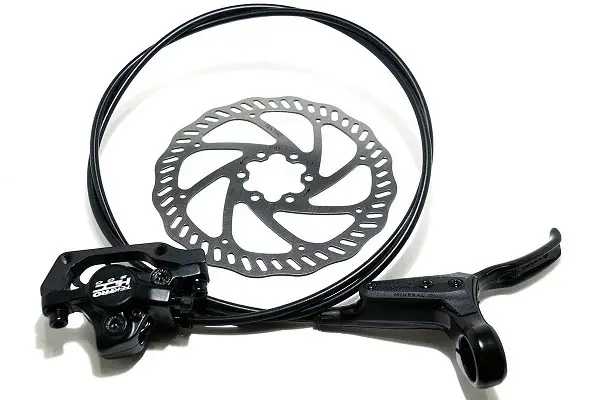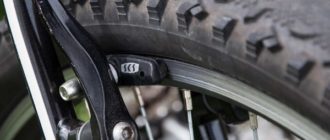It is no secret that the bicycle is a safe and environmentally friendly transport, the riding of which is good for health. However, his simple (at first glance) device has mechanisms and nodes that provide that very confidence in riding. And their serviceability – the key to your safety. The brake system of a bicycle deserves increased attention, and today we will talk about one small, but very important element. You know what they say, the small by the smallest of means: the bike caliper. What is this part? And why should you pay close attention to it from time to time? It turns out that the effectiveness of the entire braking system depends on this small element. In particular, the bicycle caliper transmits the force impulse from the brake handle to the pads, thereby stopping the movement.
Types of brakes
The bicycle industry is evolving in its wake. A separate direction is the development and improvement of the bicycle braking system. Agree, bikes for leisurely riding around town and sports competitions are different from each other and the requirements for them, respectively, too.
We can distinguish four types of brakes:
- drum brakes (foot brakes, foot brakes and, more recently, hand brakes);
- rim;
- disk brakes;
- Roller brakes.
Each has its own pros and cons. Experienced cyclists unanimously say that disc and rim designs remain the most effective and reliable. Consider each type separately.
Drum .
Their principle of operation is known to anyone who rode an old Soviet bicycle: you just need to pedal in the opposite direction to slow down or stop completely. The rotating drum is located in the rear hub of the bicycle, and inside are the brake pads. During braking, they move apart as they press against the walls of the drum and rub against its surface. Now a similar design can be seen on city bicycles with planetary control, on children’s and inexpensive models for adults. There are advantages to such a simple design:
- Durability (the mechanism is of the closed type, so moisture, dirt and dust practically do not get inside).
- Low wear and tear on the wheel rim.
- Easy and convenient servicing.
- Efficient and reliable (works even if the rim is deformed).
There is also a spoon of tar in this barrel of honey. Let’s talk about the disadvantages:
- Requires considerable effort to brake.
- There is a “blind spot”: you cannot brake with the cranks upright.
- There is a certain degree of risk: if the chain is off the sprocket, the bike cannot be stopped.
In addition, this type of braking system is not safe. In particular, sometimes you need to brake in an instant, and with a drum design, it takes time to go from forward motion to the start of braking. Sometimes it’s those seconds that make all the difference.
Rim brakes
A fairly popular type of braking system in which braking is accomplished by the contact between the brake pads and the wheel rim. Typically, the pads are made of a soft material so that when braking, they rather than the wheel rim rubs off.
Rim brakes are of mechanical and hydraulic type. There are also V-brake and U-brake, pincer (can be seen on roadsters), cantilever and the hydraulic itself (a rare guest in the cycling world). The most popular are V-brakes, so we tell separately about the advantages of this type of rim brakes:
- Simple design with a fairly good brake reinforcement.
- Relatively low weight.
- Acceptable cost.
The disadvantages, of course, there are and they are not so few:
- Low performance when mud gets in.
- Rapid wear of the rim and the brake pads themselves.
- You can not install wide tires.
Nevertheless, this type is widespread. The designs are used on virtually all types of bicycles. They are especially loved by sports and urban models of bikes.
Discs
Adapted, they came to us from the automotive industry. Now we can say with certainty that disc brakes are the most effective, reliable and durable of all existing analogues. Depending on the type of drive distinguish mechanical and hydraulic.
In the mechanical disc brake, the force from the handle is transmitted through a cable, and in the hydraulic – through a hydraulic tube filled with brake fluid. In a mechanical brake, when the knob is depressed, the cable is stretched, which transmits the force to the pads. They, in turn, pressing against the disc, stop the movement.
What the caliper is for
The caliper is a vital part of the disc braking system. It is responsible for the full operation of the braking mechanism. In appearance and operation the caliper looks like a normal compass. Bicycle caliper is used when it is necessary to move or expand the brake pads. The caliper transmits the force of the turning device to the brake pads and is what is known as a brake caliper holder. This is a very important part of the braking system, so calipers must be strong, reliable and adjusted to the specific bike model.
Bicycle Caliper
The caliper is most commonly made from a strong aluminum alloy, less commonly made from magnesium. There are also two-piece bicycle calipers, made of two parts, which are fastened to each other with bolts. Calipers are of two types:
- with one piston;
- with two pistons.
Extended pads can be attached to the latter type of calipers. Universal mounts are commercially available, with corresponding holes, with which a bicycle caliper can be attached to almost any fork. The functional importance of the caliper cannot be overemphasized, so it must be in good condition, as well as appropriate for the specific bike model.
Which is better: mechanical or hydraulic?
It is impossible to give a definite answer. Thus, in a mechanical system, the braking force is transmitted to the bicycle caliper by means of a metal cable, and in a hydraulic system – by a hydraulic line. Mechanical calipers have their own advantages:
- affordable cost;
- mechanical calipers are easier to install (although it is necessary to regularly tighten them);
- Easy maintenance and repair.
There are pluses in hydraulics as well:
- higher power;
- The compact size of the calipers;
- the best modulation among all existing variants of brake systems.
We can conclude: disc-type bicycle brakes are the leaders among modern analogues. And for a measured and unhurried riding the average cyclist is quite suitable easy to maintain and affordable disc brakes.
Conclusion
Any cyclist, opening season, should understand that the serviceability of the bike – a guarantee of safety not only him but also other road users. Therefore, check the serviceability of the braking system and the condition of the pads and caliper should be checked regularly, not when the braking process is not as planned. The relatively small caliper plays a significant role in the efficiency and reliability of the entire braking system. Therefore, it should be selected according to the model of the bike. Whichever type of braking system you choose, the caliper requires care and extra attention. Remember that timely maintenance of the bike and competent repair is a guarantee of safe and comfortable riding.









